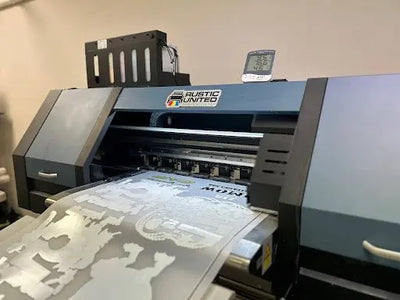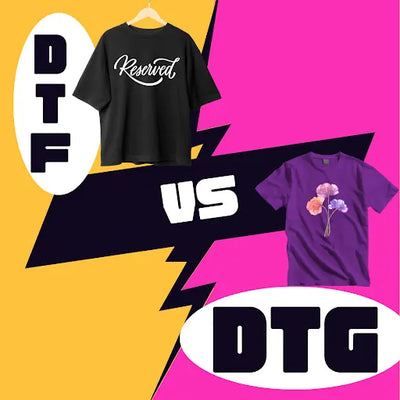

Unlocking DTF Printing Meaning | A Clear Guide
Mar 4, 2024 (Updated on Sep 26, 2025)
Welcome to our comprehensive guide on DTF printing! If you've been curious about this revolutionary method in the custom printing industry, you're in the right place. In this article, we will uncover the , process, and benefits of DTF printing meaning, providing you with a clear understanding of its capabilities. So, let's dive in and discover the exciting world of DTF printing together!
Key Takeaways:
- DTF printing is a groundbreaking method that allows businesses and individuals to create vibrant, high-resolution designs on various substrates.
- It involves printing designs onto PET film, which is then heat pressed onto the desired surface.
- DTF printing offers superior quality, durability, and versatility, revolutionizing custom apparel innovation.
- The rise of DTF printing is reshaping the market and providing businesses with a competitive edge.
- By incorporating DTF printing in your business, you can expand offerings and reach a wider market.
The Rise of DTF Printing
DTF printing has rapidly gained recognition and popularity in the custom printing industry. Businesses and individuals are increasingly choosing DTF printing over traditional methods like DTG printing due to its numerous advantages and benefits.

Superior Quality and Vibrancy
One of the key advantages of DTF printing is its ability to deliver exceptional quality and vibrancy in prints. With its high-resolution capabilities, DTF printing ensures that designs are reproduced with utmost clarity and detail, resulting in stunning visuals. The vibrant colors produced by DTF printing make designs truly stand out and catch the eye.
Excellent Washability and Longevity
DTF printing offers excellent washability, ensuring that designs stay intact even after multiple washes. This is a crucial factor for businesses that offer custom apparel, as it guarantees that the prints will remain vibrant and durable for a long time. Customers can enjoy their personalized garments without worrying about fading or deterioration.
Versatility in Product Offerings
One of the biggest advantages of DTF printing is its versatility in terms of the substrates and products it can work with. Unlike other printing methods that are limited to specific materials, DTF printing can be applied to a wide range of substrates, including but not limited to cotton, polyester, leather, and even hard surfaces.
This opens up a world of possibilities for businesses, allowing them to cater to diverse customer demands and expand their product offerings.
"DTF printing not only revolutionizes the custom printing market but also provides businesses with the opportunity to offer unique and personalized products that stand out from the competition." - PrintPro
The impact of DTF printing on the market has been significant. It has reshaped the custom printing industry by offering superior quality, excellent washability, and versatility in product offerings.
Businesses that embrace DTF printing gain a competitive edge, providing their customers with unparalleled customization options and ensuring customer satisfaction.
As DTF printing continues to evolve, its influence on the market is expected to grow. More businesses are recognizing the benefits of DTF printing and incorporating it into their operations, further fueling its impact and driving the demand for custom printed products.
How DTF Printing Works
Understanding the DTF printing process is key to unlocking the potential of this revolutionary technique. Here, we break down the step-by-step process, the required tools, and equipment involved in achieving high-quality DTF prints.
1. Create a Digital Design
To begin the DTF printing process, you need a digital design. This can be created using graphic design software like Adobe Photoshop or Illustrator. Ensure that your design is optimized for DTF printing, with high resolution and vibrant colors.
2. Print onto Specialized PET Film
Using a DTF printer and water-based pigment inks, your digital design is printed onto specialized PET film. This film acts as a transfer medium for your design, ensuring precise and accurate image reproduction.
3. Apply Hot Melt Adhesive Powder
Once the design is printed, a hot melt adhesive powder is applied to the design, bonding to the ink. This adhesive plays a crucial role in transferring the design onto the final substrate.
4. Heat Press or Heat Tunnel
The film with the adhesive powder is then passed through a heat press or heat tunnel. The heat and pressure cause the adhesive to melt and cure, preparing it for application onto the substrate. This step ensures a strong and durable bond between the design and the substrate.
Required Tools and Equipment
To successfully execute the DTF printing process, the following tools and equipment are required:
- DTF printer
- DTF ink
- PET film
- Hot melt adhesive powder
- Heat press or heat tunnel
These tools and equipment are specifically designed for DTF printing and are crucial in achieving high-quality results.

Now that you understand how DTF printing works and the tools required, you're ready to explore the endless possibilities of this innovative printing technique.
Pros and Cons of DTF Printing
DTF printing offers a range of advantages that make it an appealing choice for businesses looking to offer high-quality custom prints. Here are some key benefits:
- Versatility: DTF printing allows for printing on a wide variety of substrates, including cotton, polyester, leather, and hard surfaces, expanding the range of products businesses can offer.
- Superior Quality: DTF printing delivers exceptional detail and vibrancy, ensuring that designs are vivid and long-lasting, resulting in satisfied customers who are more likely to become repeat buyers.
- Capability Comparison: DTF Printing vs. DTG Printing
|
DTF Printing |
DTG Printing |
|
Allows printing on a variety of substrates |
Limited to printing on cotton and select fabrics |
|
Produces vibrant and durable prints |
Results may fade over time or with repeated washes |
|
Requires investment in specialized equipment and materials |
Requires less initial investment |
However, it's essential to consider the drawbacks of DTF printing:
- Cost: DTF printing requires a significant initial investment in specialized equipment and materials, which may pose a barrier for businesses with limited resources.
- Learning Curve: Mastering the DTF printing technique takes time and practice. Businesses should be prepared to invest resources in training their staff or hiring experienced professionals.
- Color Limitations: DTF printing can accurately reproduce a range of colors but may struggle with exact spot color matches. This limitation may affect businesses that require precise color matching for their designs.
By weighing the pros and cons, businesses can determine if DTF printing aligns with their needs and requirements.
Impact of DTF Printing on Custom Printing Market
DTF printing has revolutionized the custom printing market, leaving a lasting impact on both businesses and consumers alike. This innovative technology has set a new standard in versatility, quality, and efficiency, transforming the way we approach custom printing.
By leveraging DTF printing, businesses can swiftly adapt to evolving market trends and cater to individual customer needs, gaining a competitive edge in today's dynamic industry. The exceptional quality and vibrant colors produced by DTF printing ensure customer satisfaction and drive repeat business.
The introduction of DTF printing has also broadened the product offerings for businesses, allowing them to explore a diverse range of substrates and materials. From cotton and polyester to leather and hard surfaces, DTF printing opens up endless possibilities for customization, enabling businesses to cater to a wider audience and meet their diverse demands.
Table 1 illustrates the key benefits of leveraging DTF printing for your business:
|
Benefits of DTF Printing |
|
Superior print quality and vibrant colors |
|
Expanded product offerings on various substrates |
|
Ability to respond quickly to market trends |
|
Enhanced customization options for individual customer needs |
|
Competitive edge in the dynamic custom printing industry |
In conclusion, DTF printing has had a profound impact on the custom printing market by redefining expectations and setting new industry standards. By leveraging DTF printing, businesses can differentiate themselves, expand their offerings, and drive growth in a rapidly evolving industry.
Incorporating DTF Printing in Your Business
At DTF Dallas, we understand the importance of staying ahead in the custom printing industry. That’s why we offer strategic solutions for incorporating DTF printing into your business, allowing you to elevate your operations and expand your offerings. There are two main approaches to incorporating DTF printing: bringing it in-house and selling transfers.
Bringing DTF Printing In-House
By investing in the necessary equipment, such as a DTF printer and related tools, you can bring DTF printing in-house. This decision provides several benefits:
- Full Control: With in-house DTF printing, you have complete control over the entire process, from design to production. This allows you to ensure the highest quality and customization for your customers.
- Quick Turnaround: Bringing DTF printing in-house eliminates the need to outsource printing services, resulting in faster turnaround times and increased efficiency.
- Expanded Capabilities: Having DTF printing capabilities in-house allows you to explore new business opportunities. You can offer custom DTF prints directly to your customers, expanding your product offerings and attracting a broader customer base.
With our expertise and industry-leading equipment, we can guide you through the process of setting up an in-house DTF printing system. From selecting the right printer to providing training and support, we ensure a seamless integration into your business.
Expanding Offerings by Selling Transfers
If you're looking to expand your market reach and generate additional revenue streams, selling DTF transfers can be a lucrative option. DTF transfers are high-quality prints that can be applied to various substrates by other businesses or individuals. This approach offers several advantages:
- Broader Market Reach: By selling DTF transfers, you can reach a wider audience of businesses and individuals who might not have their own DTF printing capabilities. This expands your customer base and opens up new opportunities for growth.
- Additional Revenue Streams: Selling transfers allows you to diversify your offerings and generate income beyond direct printing services. Transfers can be sold in bulk or as individual designs, providing flexibility and catering to different customer preferences.
- Streamlined Production: Focusing on producing transfers can streamline your production process and reduce operational complexities. It allows you to optimize your resources and allocate them effectively between transfer production and other printing services.
At DTF Dallas, we can assist you in creating high-quality DTF transfers that meet the demands of your target market. From design optimization to transfer production, we ensure that your transfers stand out and deliver exceptional results.
By incorporating DTF printing in-house or expanding your offerings through transfer sales, you can take advantage of the capabilities and growth opportunities that this innovative printing method offers. Contact us today to explore how our expertise and solutions can help you leverage DTF printing for the success of your business.
Tips for Successful DTF Printing
When it comes to achieving successful DTF printing, there are several tips and best practices that can greatly enhance your results. By following these guidelines, you can ensure that your prints come out vibrant, accurate, and long-lasting.
Use High-Quality Designs and High-Resolution Files
Optimizing your designs specifically for DTF printing is crucial for achieving the best results. Make sure your designs are of high quality and resolution, as this will directly impact the final print output. Working with high-resolution files ensures that the intricate details and vibrant colors are accurately reproduced in your prints.
Set Up Correct Color Settings
The right color settings are essential for achieving accurate and vibrant colors in your DTF prints. Take the time to set up the correct color profiles and settings in your design software, such as Photoshop and Illustrator. This will ensure that the colors appear as intended and that your prints match your desired color palette.
Calibrate Your DTF Printer
Calibrating your DTF printer is crucial for consistent color reproduction. Regularly check and adjust the color calibration settings of your printer to maintain accurate color output. Calibration helps ensure that colors are reproduced consistently across multiple prints, eliminating variations that can occur over time.
Choose the Appropriate Transfer Film
The choice of transfer film plays a significant role in achieving better DTF prints. Different transfer films have different characteristics and adhesion properties, and selecting the right film for your specific application is important. Consider factors such as substrate type, durability requirements, and color vibrancy when choosing the appropriate transfer film for your prints.
Print on a Smooth, Clean Surface
Printing on a smooth, clean surface is vital for optimal adhesion and print quality. Make sure the surface you are printing on is free from any debris or imperfections that could affect the transfer process. A clean surface ensures that the ink and adhesive transfer smoothly, resulting in crisp, vibrant prints.
Follow Proper Curing and Washing Instructions
For long-lasting and high-quality DTF prints, it is crucial to follow the recommended curing and washing instructions. Proper curing ensures that the ink and adhesive are fully bonded to the substrate, enhancing durability and washability. Follow the manufacturer's instructions for curing times and washing temperatures to maintain the longevity and quality of your prints.
Incorporating these tips into your DTF printing process will help you achieve better results and ensure customer satisfaction. Remember to optimize your designs, set up correct color settings, calibrate your printer, choose the appropriate transfer film, print on a smooth surface, and follow proper curing and washing instructions. By applying these best practices, you can unlock the full potential of DTF printing and deliver outstanding prints that impress your customers.
Conclusion
DTF printing has revolutionized the custom printing industry, empowering businesses and individuals to create stunning, high-quality designs on various substrates. Through this innovative process, vibrant and durable prints can be achieved, offering endless opportunities for creative expression.
The key to successful DTF printing lies in understanding the process, utilizing the right equipment, and optimizing color settings. By considering the advantages and drawbacks of DTF printing, businesses can make informed decisions that align with their goals and customer demands.
With DTF printing, businesses can differentiate themselves in the market by offering superior quality and versatility. They can expand their product offerings to include a wide range of substrates, from fabrics to hard surfaces. By leveraging the benefits of DTF printing, businesses can meet customer demands effectively and stay ahead of the competition.
DTF printing opens up a world of possibilities for custom apparel innovation, allowing businesses and individuals to bring their unique designs to life with exceptional detail and vibrancy. As this printing process continues to advance, it will undoubtedly shape the future of the custom printing industry, unlocking new creative opportunities for all.
FAQ
What is DTF printing?
DTF printing is a revolutionary method in the custom printing industry that involves printing high-resolution images onto PET film, which is then heat pressed onto various substrates to create vibrant, full-color designs with superior quality and durability.
How does DTF printing work?
The DTF printing process starts with creating a digital design, which is then printed onto specialized PET film using a DTF printer and water-based pigment inks. A hot melt adhesive powder is applied to the design, which adheres to the ink. The film with the adhesive powder is then heat pressed to melt and cure the adhesive, preparing it for application onto the desired substrate.
What are the advantages of DTF printing?
DTF printing offers superior quality and vibrancy, exceptional washability and longevity, and the ability to print on a wide range of substrates including cotton, polyester, leather, and hard surfaces. It also provides businesses with the flexibility to respond to market trends and customer demands quickly.
How does DTF printing differ from DTG printing?
DTF printing differs from DTG (Direct-to-Garment) printing in the printing process. DTF printing involves printing on PET film, while DTG printing prints directly onto the fabric. DTF printing offers better vibrancy, washability, and versatility compared to DTG printing.
What are the drawbacks of DTF printing?
DTF printing requires a significant initial investment in specialized equipment and materials. It also has a learning curve and can only reproduce a limited range of colors accurately, making it unsuitable for exact spot color matches.
How has DTF printing impacted the custom printing market?
DTF printing has reshaped the market by setting a new standard in versatility, quality, and efficiency. It allows businesses to offer a wide range of customized products, quickly respond to market trends, and meet individual customer needs, providing a competitive edge.
How can I incorporate DTF printing into my business?
There are two options for incorporating DTF printing into your business. You can bring DTF printing in-house by investing in the necessary equipment and offering custom DTF prints directly to your customers. Alternatively, you can produce DTF transfers and sell them to other businesses or individuals who can apply the transfers themselves.
What are some tips for successful DTF printing?
Some tips for successful DTF printing include using high-quality designs optimized for DTF printing, setting up the correct color settings in design software, calibrating the DTF printer for consistent color reproduction, choosing the appropriate transfer film, and following proper curing and washing instructions.
What is the significance of DTF printing?
DTF printing allows businesses and individuals to create high-quality, vibrant, and durable designs on a wide range of substrates, opening up endless possibilities for custom apparel innovation and creative expression.
Comments 0
Be the first to leave a comment.




